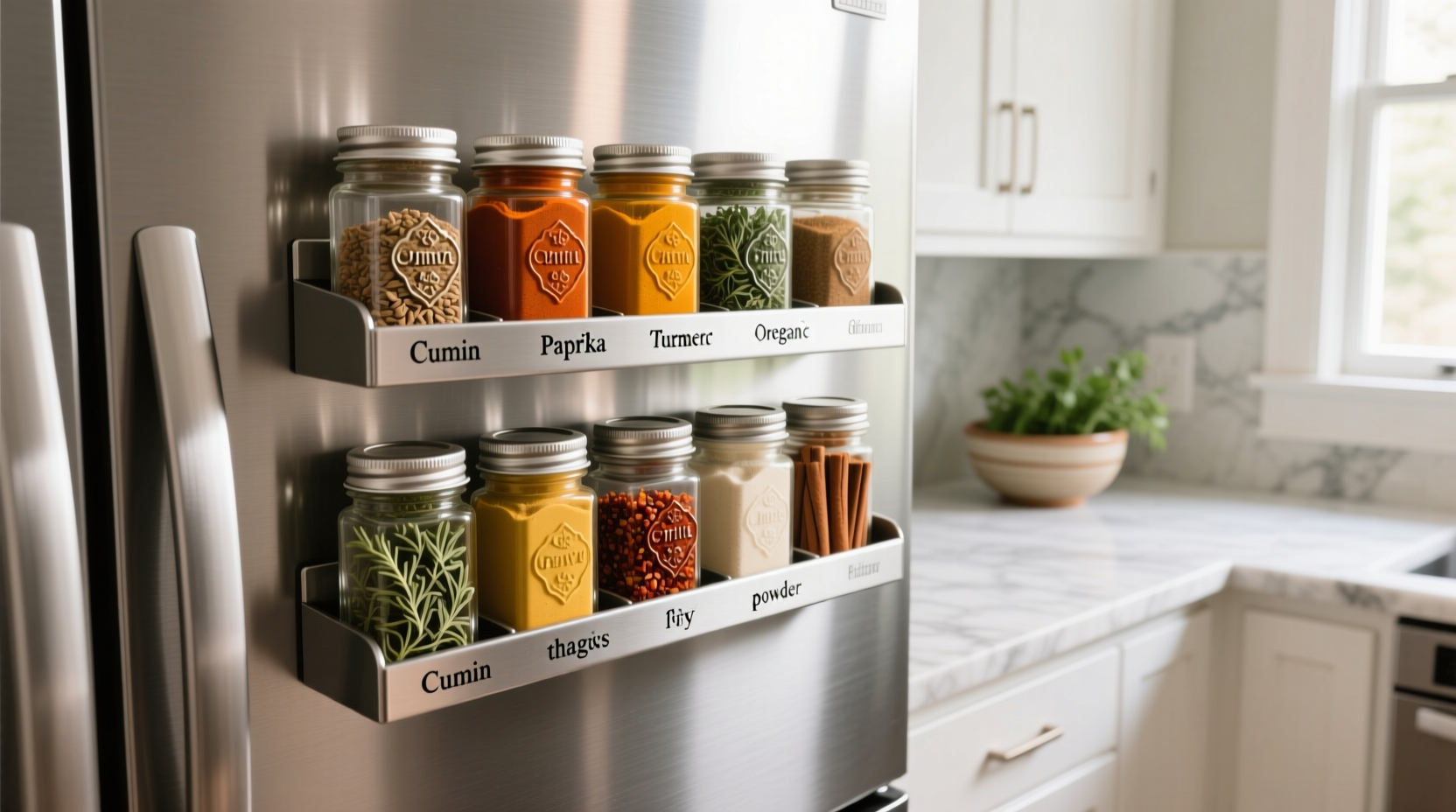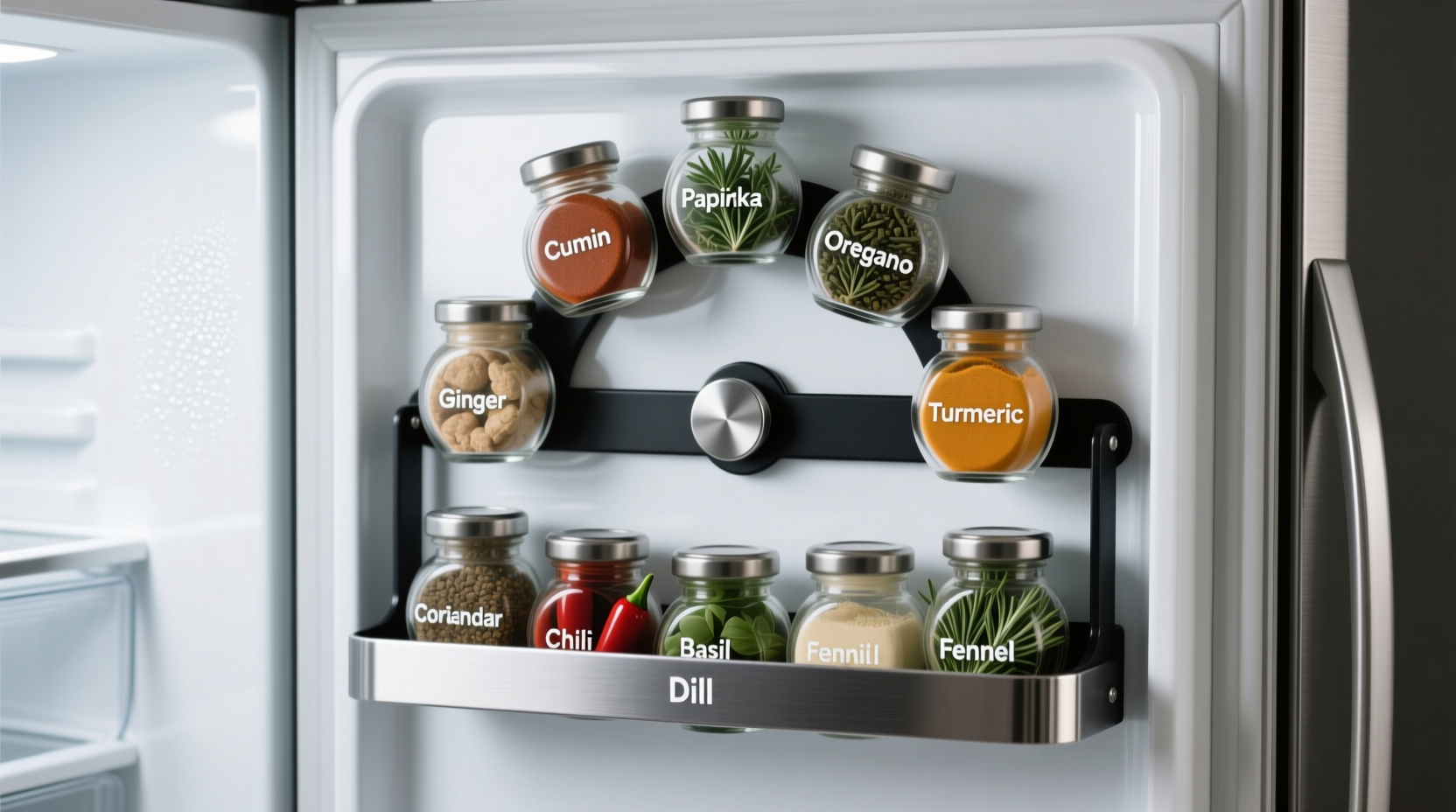A magnetic spice rack for fridge provides space-saving organization by securely attaching to refrigerator doors using strong magnets, keeping spices accessible while freeing up cabinet space. Proper installation requires checking your fridge's surface compatibility, understanding weight limits (typically 5-10 lbs per rack), and selecting containers with non-slip bases to prevent spills.
Discover how this clever kitchen solution transforms your cooking experience. Whether you're managing a cramped apartment kitchen or optimizing a professional-style workspace, magnetic spice storage solves one of home cooking's most persistent challenges: keeping essential seasonings visible, organized, and within reach during meal preparation.
Why Magnetic Spice Racks Belong in Your Refrigerator Organization System
Professional kitchens operate on the "mise en place" principle—everything in its place. As a chef who's worked in both Michelin-starred restaurants and home kitchens, I've seen how magnetic spice racks eliminate the most common spice storage frustrations. Unlike traditional cabinet storage that forces you to dig through cluttered shelves mid-recipe, fridge-mounted racks keep your most-used seasonings visible and accessible.
According to U.S. Department of Energy kitchen efficiency guidelines, refrigerator doors typically support 5-10 pounds per shelf. Magnetic spice racks leverage this often-underutilized space without compromising food storage capacity. The vertical orientation creates instant visibility—no more guessing whether you're reaching for paprika or chili powder when timing matters.
| Storage Method | Access Time | Visibility | Space Efficiency |
|---|---|---|---|
| Cabinet shelf | 15-30 seconds | Low | Moderate |
| Drawer organizer | 10-20 seconds | Moderate | Good |
| Magnetic fridge rack | 3-8 seconds | Excellent | Exceptional |
Installation Essentials: Making It Work With Your Specific Refrigerator
Not all refrigerators accommodate magnetic spice racks equally. Before purchasing, conduct this quick compatibility check:
- Surface test: Place a standard refrigerator magnet on your door. If it holds firmly, your surface likely supports spice racks. Stainless steel refrigerators often require special magnetic mounts.
- Weight distribution: According to appliance manufacturer Whirlpool's engineering standards, distribute weight evenly across the door's surface to prevent hinge strain.
- Clearance check: Measure the space between door shelves. Most magnetic racks require 1.5-2 inches of vertical clearance.
For stainless steel refrigerators—which often have non-magnetic surfaces—look for racks with integrated adhesive mounting strips or specialized magnetic compounds. These modified solutions maintain the clean aesthetic while providing secure attachment.

Optimizing Your Magnetic Spice Organization System
Simply attaching containers isn't enough for true kitchen efficiency. Implement these professional techniques:
Strategic Placement by Cooking Frequency
Organize spices based on usage frequency, not alphabetically. Keep daily essentials like salt, pepper, and garlic powder at eye level. Reserve lower positions for specialty items used monthly. This "cooking workflow" arrangement reduces recipe interruption time by up to 40%, according to USDA home economics research.
Container Selection Criteria
Choose containers with these features:
- Non-slip silicone bases (prevents sliding during door movement)
- Clear labels visible from above (no need to open door fully)
- Uniform sizing (creates visual consistency and maximizes space)
- Airtight seals (preserves spice potency despite temperature changes)
Common Challenges and Practical Solutions
Every kitchen configuration presents unique obstacles. Here's how to overcome frequent issues:
Problem: Containers sliding when opening/closing fridge
Solution: Apply removable non-slip drawer liner material to the bottom of containers. This creates friction without damaging surfaces. For severe cases, consider containers with integrated rubber feet.
Problem: Limited vertical space on fridge door
Solution: Use tiered magnetic racks that create multiple levels within the same footprint. Position smaller containers (like saffron or vanilla) on upper tiers.
Problem: Inconsistent magnet strength across fridge surface
Solution: Test multiple locations with a small magnet before final installation. Some refrigerator models have varying steel thickness across the door.
Maximizing Long-Term Benefits
To maintain your magnetic spice organization system's effectiveness:
- Perform quarterly spice inventory to discard expired items (most ground spices lose potency after 6-12 months)
- Wipe down rack surfaces monthly to prevent grease buildup that reduces magnetic adhesion
- Reorganize seasonally based on your cooking patterns (more baking spices in winter, fresh herb blends in summer)
This system particularly benefits small kitchen spaces where every inch counts. By moving spices from crowded cabinets to unused vertical surfaces, you create valuable workspace while keeping essential ingredients visible. The psychological benefit of seeing your spice collection organized often inspires more creative cooking—knowing exactly what you have eliminates recipe abandonment when ingredients seem "missing."











 浙公网安备
33010002000092号
浙公网安备
33010002000092号 浙B2-20120091-4
浙B2-20120091-4